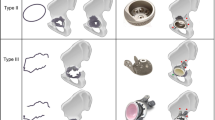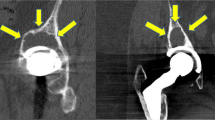Abstract
We report on our experiences with internal hemipelvectomy followed by an implantation of a endoprosthetic pelvic replacement (EPR) performed in 15 patients over a period of 15 years. Our primary aim was to determine the indications for this procedure because of its high rate of complications. Due to the malignant character of the disease and the biomechanical stress on the anatomical region, the demands on the surgeon are high. The most important factor is a sufficiently wide resection of the primary tumour because most are chondrosarcomata which do not respond to other therapies. In addition, the malignant character of the tumour has the greatest influence on the long-term results. Internal hemipelvectomy and endoprosthetic pelvic replacement are accompanied by a high rate of operative and postoperative complications. Nevertheless, nearly full anatomical and functional reconstruction can be obtained provided a medium level of function is accepted. Follow-up results of the remaining six still living patients were evaluated by means of three different scoring systems. All patients had only a medium score but emphasised subjective acceptance of the endoprosthetic pelvic replacement even when removal was necessary later on. Because of the lower functional outcome of alternative operative procedures such as pseudarthroses and arthrodeses and problems with the replantation of autoclaved autografts or implantation of an allograft, internal hemipelvectomy combined with endoprosthetic pelvic replacement is the treatment of choice for these specific acetabular lesions, provided a complete resection is feasible. Otherwise, an external hemipelvectomy is necessary because even alternative limb-salvaging procedures must incorporate the same complete resection of the tumour. In cases of metastatic lesions, internal hemipelvectomy and endoprosthetic pelvic replacement are indicated relatively because of the systemic character of the disease. The procedure should be considered only when resection of a solitary metastasis enables a cure and/ or prolongation of ilfe with an improved quality of life.
Similar content being viewed by others
References
Burri C, Claes L, Gerngroß H, MathysR Jr (1979) Total “internal” hemipelvectomy. Arch Orthop Trauma Surg 94:219–226
Dahmen G, Heise U (1985) Alloplastischer Beckenteilersatz mit Hüftgelenk und proximalem Femur. Z Orthop 123:265–272
Dunham WK Jr (1987) Acetabular resections for sarcoma. In: Enneking WF (ed) Limb salvage in musculoskeletal oncology. (Bristol-Myers/Zimmer Orthopaedic Symposium). Churchill Livingstone, New York, pp 170–186
Enneking WF, Menendez LR (1987) Functional evaluation of various reconstructions after periacetabular resection of iliac lesions. In: Enneking WF (ed) Limb salvage in musculoskeletal oncology. (Bristol-Myers/Zimmer Orthopaedic Symposium) Churchill Livingstone, New York, pp 117–135
Gradinger R, Hipp E (1989) A custom-made adaptable pelvic prosthesis. In: Yamamuro T (ed) New developments for limb salvage in musculoskeletal tumors. (Kyocera Orthopaedic Symposion Tokyo) Springer, Berlin Heidelberg New York, pp 475–479
Gradinger R, Rechl H, Hipp E (1991) Pelvic osteosarcoma. Clin Orthop 270:149–158
Gradinger R, Rechl H, Plötz W, Ascherl R, Hipp E (1993) Endoprothetischer Teilersatz des Beckens bei malignen Tumoren. Orthopade 22:167–173
Harrington KD (1992) The use of hemipelvic allografts or autoclaved grafts for reconstruction after wide resections of malignant tumors of the pelvis. J Bone Joint Surg [Am] 74:331–341
Johnson JTH (1978) Reconstruction of the pelvic ring following tumor resection. J Bone Joint Surg [Am] 60:747–751
Mutschler W, Burri C (1990) “Innere” Hemipelvektomie und Beckenersatz. Oper Orthop Traumatol 2:1–13
Mutschler W, Burri C, Kiefer H (1987) functional results after pelvic resection with endoprosthetic replacement. In: Enneking WF (ed) Limb salvage in musculoskeletai oncology. (BristolMyers/Zimmer Orthopaedic Symposium) Churchill Livingstone, New York, pp 156–166
Ritschl P, Kickinger W, Feldner-Busztin H, Windhager R, Kotz R (1989) Pelvic and sacrum resections. In: Yamamuro T (ed) New developments for limb salvage in musculoskeletal tumors. (Kyocera Orthopaedic Symposium Tokyo) Springer, Berlin Heidelberg New York, pp 491–502
Shin KH, Rougraff BT, Simon MA (1994) Oncologic outcomes oiprimary bone sarcomas of the pelvis. Clin Orthop 304:207.
Steel HH (1978) Partial or complete resection of the hemipelvis. J Bone Joint Surg [Am] 60:719–730
Stephenson RB, Kaufer H, Hankin FM (1989) Partial pelvic resection as an alternative to hindquarter amputation for skeletal neoplasms. Clin Orthop 242:201–211
Author information
Authors and Affiliations
Rights and permissions
About this article
Cite this article
Bruns, J., Luessenhop, S.L. & Dahmen sen, G. Internal hemipelvectomy and endoprosthetic pelvic replacement: long-term follow-up results. Arch Orthop Trauma Surg 116, 27–31 (1997). https://doi.org/10.1007/BF00434096
Received:
Issue Date:
DOI: https://doi.org/10.1007/BF00434096




